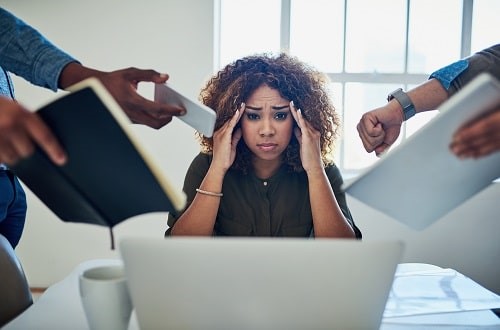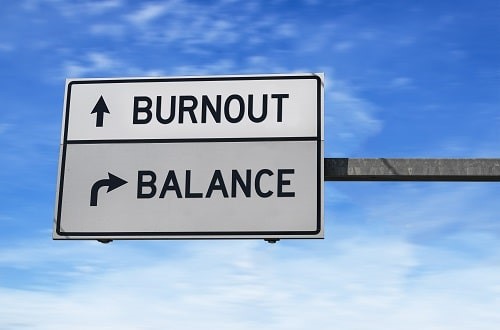Multiple surveys published at the beginning of the year signalled high levels of stress and burnout among UK workers. We investigate what’s causing this, and what can be done about it.
Features
Burnout Britain: how can we reduce stress and put out the fire?
As the fireworks signalling the start of 2024 fizzled out, a glut of reports on workplace wellbeing pointed to a different type of burnout.
One-fifth of UK workers feel burnt out, according to one piece of research released in January by human resources company HiBob, while 70 per cent of employees are planning to look for a new job this year. Another January report, from Mental Health UK, suggested that nine out of 10 UK adults had experienced high or extreme levels of pressure or stress in the past year, and warned that the UK was at risk of becoming a “burnt-out nation”.
 Nine out of 10 UK adults experienced high or extreme levels of pressure or stress in the past year, according to a Mental Health UK report. Photograph: iStock/PeopleImages
Nine out of 10 UK adults experienced high or extreme levels of pressure or stress in the past year, according to a Mental Health UK report. Photograph: iStock/PeopleImages
In its Burnout Report – based on a YouGov poll of more than 2,000 UK adults – Mental Health UK found that one in five UK workers needed to take time off in the past year due to poor mental health caused by pressure or stress. More than a third of respondents said they did not feel comfortable letting their line managers know they felt stressed at work, while nearly half said their employer did not have a plan in place to spot signs of chronic stress and prevent burnout.
“Simply put, this temperature test of the nation’s wellbeing suggests that the UK is rapidly becoming a burnt-out nation, and a worrying number of people are taking time off work due to poor mental health caused by stress,” said Mental Health UK chief executive Brian Dow on releasing the report.
More research, published earlier this year by Mental Health First Aid (MHFA) England, pointed out that 59 per cent of employees do not regularly feel joy or satisfaction at work, prompting the organisation to ask whether we are “the unhappiest we’ve ever been at work”.
These reports were released against a backdrop of data published in November by the Health and Safety Executive (HSE), which showed that of the 1.8 million people suffering from a work-related illness in 2022–23, almost half – 875,000 – had stress, depression or anxiety caused by their jobs. These conditions were responsible for the loss of 17.1 million working days during the period.
HSE defines work-related stress, depression and anxiety as “a harmful reaction people have to undue pressures and demands placed on them at work”. The regulator has defined six key areas that can lead to work-related stress if they are not managed properly. These are: demands, control, support, relationships, role and change. Employers have a legal duty to protect employees from stress at work by carrying out a risk assessment, which they can base on these six areas.
While the HSE figures on stress for 2022–23 were flat compared with the previous year, they were higher than the 2018–19 pre-pandemic period, prior to which they had also been on the rise.
Why are so many people reporting such high levels of workplace stress, and what can employers and workers do to minimise it and prevent it from turning into burnout? Mental health and wellbeing experts point to a combination of factors and possible solutions.
Before examining these, however, it is important to emphasise that stress and burnout are two different things. While most people experience some form of stress at certain times in the workplace, burnout is defined by the World Health Organization (WHO) as a syndrome resulting from “chronic workplace stress that has not been successfully managed”. Symptoms of burnout include exhaustion, increased mental distance from one’s job and reduced professional efficacy, according to the WHO.
 Photograph: iStock/Maria Vonotna
Photograph: iStock/Maria Vonotna
The state of our individual nervous systems is central to how we deal with stress, says Mark Davies, director of 7Futures, a wellbeing consultancy that specialises in building resilience.
“You can have two people doing the same role in an organisation and they’re theoretically exposed to the same stressors, but one person seems to be managing fine while the other person seems to be struggling,” Davies tells Safety Management. “One person’s nervous system is working well, and the other person’s nervous system has, perhaps, been affected by something traumatic in their life 10 years ago, from which they’ve not fully recovered.”
Sam Downie, the new managing director at British Safety Council’s award-winning sister mental health charity Mates in Mind, agrees it is important to acknowledge that the line between stress and excessive stress depends on the individual and their circumstances.
“Everyone reacts differently to stressors and our tolerance will change depending on other factors,” says Downie. “What matters is not how much stress you can endure, but that you have the skills to identify and respond to any negative impact that stress is having on you.”
Knowing how to spot the negative signs of stress in ourselves and others is important, she adds. These signs include “feeling restless and agitated, feeling tearful and not wanting to talk to people”. Identifying the source of excessive stress can then help with deciding what action to take and where to seek support.
“For example, if your workload is too high, then speak with your supervisor, manager or HR representative to discuss what actions can be taken,” says Downie.
Rather than looking at individual sources of stress, Davies of 7Futures advises examining our overall stress load. Pointing to Hooke’s Law, whereby the extension of a spring is directly proportionate to the weights added – until the elastic limit is exceeded – he says our nervous systems react to stress in the same way.
“The elasticity of the spring represents our nervous system, and the individual weights represent the stressors,” Davies explains. “If the stress becomes too much then the integrity of the nervous system becomes a bit like the spring, and we lose our capacity to recover.
“When we lose our capacity to recover, that’s when we’re at much more risk of burnout.”
Focusing on recovering from stress is what builds resilience, notes Davies: “How we grow resilience is by practising good quality recovery, and good quality recovery can mean a number of things – the most important of which is sleep.” Building good relationships is the second most important factor, followed by a healthy diet, regular exercise and taking up hobbies outside work.
“Modern lifestyles and working practices have got in the way of recovery, so we have to become more conscious of how our nervous system works,” says Davies.
The move to working remotely during the Covid-19 pandemic made it more difficult to build strong relationships in the workplace, and Davies’ advice to companies that have continued to follow remote- or hybrid-working models is to be “very careful” about ensuring that those relationships can still thrive.
“Post-Covid working environments and social environments are not what’s causing burnout Britain, but I would say they’re a contributory factor,” he observes.
MHFA England chief executive Simon Blake agrees that the shift to working from home is partly to blame, but he also cites external factors such as money worries and geopolitical concerns.
“As many of us work more flexibly, the opportunities to connect with colleagues and the amount we move throughout the day have reduced,” says Blake. “While this change has brought some positives, the knock-on effect has been a blurring of boundaries between work and home.” This ‘always on’ culture, adds Blake, is increasingly affecting people’s energy and happiness.
“Where once our kitchens were a place of socialising and downtime, they are now, for many of us, a reminder of work and to-do lists,” he says, adding that factors outside the workplace can also affect how we feel at work: “The worst cost-of-living crisis we have seen for a generation, domestic and global events all impact on joy, satisfaction and wellbeing.”
Employers have an important role to play, says Blake, and the creation of a “psychologically safe” culture in the workplace is “vital” to improving workplace mental health and performance.
“When people feel free to be themselves and to express opinions without fear of criticism or judgement, they are more likely to contribute fully, which can help their sense of joy and how they contribute at work,” he notes, pointing to MHFA England’s ‘My Whole Self’ campaign for workplace culture change.
 Talking to line managers about workload can help with managing stress. Photograph: iStock/PeopleImages
Talking to line managers about workload can help with managing stress. Photograph: iStock/PeopleImages
“All employers can and must take action to support the creation of workplace cultures where everyone feels psychologically safe,” says Blake. “This requires a whole organisation approach where inclusion, mental health and wellbeing are baked into the business strategy, and where wellbeing and performance fuel one another.”
The British Safety Council’s head of wellbeing, Marcus Herbert, agrees that implementing a company-wide wellbeing strategy can have a significant positive impact on boosting employee engagement and reducing issues related to stress and burnout.
To make a strong business case for wellbeing within an organisation, Herbert suggests identifying the decision-makers and what their motivations are, before designing a wellbeing strategy that is based on the specific needs of the company. To help small- and medium-sized enterprises (SMEs) design and implement workplace wellbeing strategies, the British Safety Council is running a series of free-to-attend workshops around the country, as part of its ‘Keep Thriving’ campaign.
Organisations should take steps to “make it easier” for employees to look after themselves, says Davies of 7Futures, and they should provide “education, awareness and motivation” to do so. However, it is also up to individuals to “manage the basics” that are in their control, he believes.
“Stress can be out of our control but how we recover is in our control,” says Davies, pointing to “good quality self-regulating practices and habits” such as pre-sleep routines, meditation, yoga, gardening or walks in the countryside. A good pre-sleep routine would involve reducing caffeine intake after midday, relying less on sugary snacks throughout the day and avoiding screens in the run-up to bedtime.
“It is important for people to examine their technology habits and be sure to unplug from phones, laptops and TVs at least 30 minutes before going to bed, because they interfere with the production of melatonin, the hormone which helps trigger restful sleep,” Davies adds.
Mental Health UK is calling for the government to lead a “national conversation” about stress and mental health issues in the workplace.
“Part of this will involve looking at how employers can better spot and manage stress before it becomes burnout,” says Dow. “But the onus isn’t just on organisations, and while it is positive that staff are more likely to raise concerns about stress and mental health than in the past, we will need to consider what support and adjustments from employers are reasonable.”
Stress recovery tips
- Sleep! Build a pre-sleep routine into your life by reducing caffeine intake and avoiding screens late at night.
- Build good quality relationships, both inside and outside the workplace, and talk about how you’re feeling.
- Eat a well-balanced diet that does not revolve around temporary sugar ‘fixes’ throughout the day.
- Move regularly and find a form of exercise that you enjoy.
- Take up hobbies outside the workplace, such as yoga, walking or gardening.


FEATURES

India’s path to net zero: a work in progress
By Orchie Bandyopadhyay on 08 April 2025
India is implementing a variety of clean energy measures to hit its target of net zero greenhouse gas emissions by 2070, including plans to rapidly scale up the generation of nuclear power. However, climate experts say significant finance will be required from developed countries to phase out coal power, accelerate renewables deployment and expand the national electricity grid.

Too hot to handle: early arrival of heatwaves in India sparks calls for action to protect workers and the public
By Orchie Bandyopadhyay on 08 April 2025
Temperatures in India in February 2025 were the hottest since records began over a century ago, prompting warnings the country needs to urgently step up efforts to protect both workers and the general population from the health risks posed by extreme heat and humidity.

